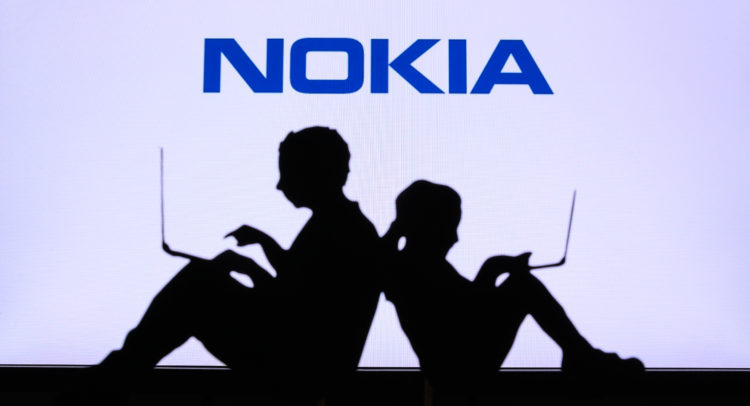Once, Nokia (NOK) was the leader in mobile phone technology. Creators of some of the most durable hardware around, those who had cell phones often had Nokias in their pockets and side holsters. The rise of the smartphone hit Nokia hard, and now, it’s a much different company.
Citigroup (C) likes what it sees, though, as the company gained 2.8% in Tuesday’s premarket after Citi analyst Andrew Gardiner hiked his price target from €6 to €6.50 and raised his rating from Neutral to Buy. Most of the stock’s gains continued into Tuesday’s session.
Meanwhile, I’m bullish on Nokia, thanks to much the same reasons that prompted Citi to upgrade the company. There’s a lot going on under the hood at Nokia. The rise of mobile technology makes Nokia particularly attractive. Its valuation doesn’t hurt matters either.
The last 12 months for Nokia have been a bit up and down, though in a tight range. At its best in December 2021, Nokia came in at around $6.38 per share. At its worst in March 2022, it was closer to $4.50 per share. Today, it’s under $5.
Wall Street’s Take
Turning to Wall Street, Nokia has a Moderate Buy consensus rating. That’s based on three Buys and two Holds assigned in the last three months. The average Nokia price target of $7.41 implies 59% upside potential.

Analyst price targets range from a low of $6.49 per share to a high of $9 per share.
Investor Sentiment is Less Encouraged
Things could be much worse at Nokia. TipRanks currently has a Smart Score of 7 out of 10 on the company, putting it at the highest level of “neutral.” That gives it a slightly better-than-even chance that the company will outperform the broader market. Despite this, many investor sentiment metrics don’t hold out much hope.
Hedge fund involvement, as measured by the TipRanks 13-F Tracker, is down significantly. Hedge funds reduced their Nokia holdings by around 815,000 shares last quarter. Given that the reduction was from around 8.352 million shares in December 2021, however, there’s still quite a bit of Nokia held at the hedge fund level.

Insider trading, however, is a different story. There are no reports of insider trading in any direction.
Meanwhile, retail investors—particularly those who hold portfolios on TipRanks—are getting out of Nokia at a pretty good clip. Not only are TipRanks portfolios that hold Nokia stock down 0.5% in the last seven days, but they’re also down 1.6% in the last 30 days.
As for Nokia’s dividend history, there’s good news and bad news therein. Nokia stopped paying dividends in July 2019. However, the company seems to have restarted the payments, though almost on a token level. It offered a dividend of $0.01 per share on May 2, 2022.
Mobile’s Growth is Good News for Nokia
When Citi offered its upgrade that took Nokia from Neutral to Buy, it had a solid set of reasons behind it. Nokia is doing well as a provider of mobile infrastructure. In fact, it recently noted that it looks for 6G connectivity to come out by 2030, though it may not be mobile devices that will access it.
Citi also pointed out that Nokia is part of a larger market that stands to make some headway as well. Nokia is part of the networking hardware and software market. With more and more businesses looking to engage in hybrid operations, demand is on the rise for the tools necessary to connect therein.
Better yet, 5G wireless networking technology represents an excellent opportunity to bridge the so-called “digital divide,” where people living in rural areas have less access to high-speed internet than their urbanite counterparts.
There’s a big market for people looking for high-speed internet that can’t get it from cable or fiber, and wireless may be just the ticket to breaking into that market. Further, Nokia can hold its own in mobile as well; the urbanites who may not need 5G–or even 6G–from home may need it for their mobile devices.
So, Nokia works in three markets at once that are all looking at growth. That could make Nokia a force to be reckoned with down the line, and it actually gets better from there. With Nokia currently trading under $5 per share, it offers a potentially-excellent buy-in point.
Granted, the macroeconomic picture is slipping by the day. That’s going to crimp some potential demand from both regular consumers and businesses. Closed businesses and homeless people don’t pay a lot for networking tools and internet access. However, there’s a silver lining to that dark cloud; Internet access is one of the last things people give up.
Internet access is almost as vital as power or water these days. It’s valuable as a cheap source of entertainment. It’s also a powerful business tool. Whether you’re working from home or looking for work, you’re doing so with an Internet connection. That’s going to make Nokia fairly resistant to a potential future recession.
Concluding Views
Right now, Nokia is priced so attractively that it really only has two options: improve its share price or fold altogether. Given its presence in the networking and mobile markets, it’s not likely to do that. It’s got a great potential here to build the next stage of Internet access as we know it.
What Nokia is doing right now makes it reasonably attractive. What Nokia could be doing tomorrow is even better. Take a positive today and a potentially explosive tomorrow, and the end result could be a wonderful thing for investors getting in under the $5 mark today. That’s why I’m bullish on Nokia.
















